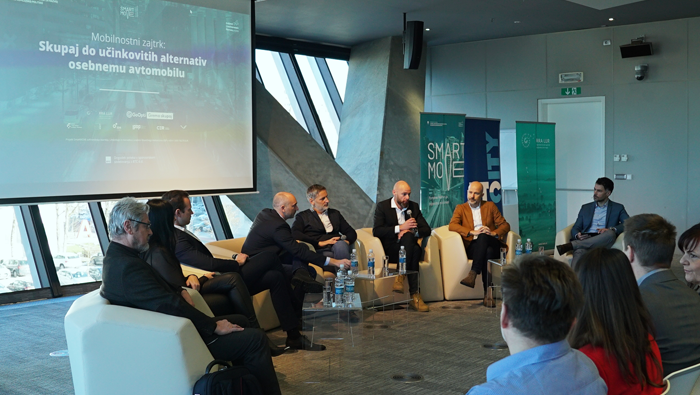The future of mobility lies in the cooperation of public passenger transport and alternative forms of transport
On January 31st experts in sustainable mobility, representatives of Ljubljana Passenger Transport (LPP), Slovenian Railways – Passenger Transport (SŽ-PP) and the Ministry of Infrastructure sat together over a debate with providers of new forms of transport, the companies GoOpti, Nomago and Avantcar, to identify synergies and the possibility of formation of a system of multimodality, which would enable effective daily migrations without a personal car.
One of the biggest challenges of sustainable mobility is the mass use of a personal car for the transport of a single person. It is the common cause of traffic jams and overcrowded parking lots which many of us experience on a daily basis, as well as of high environmental burdens we will leave to the future generations.
“The development of a multimodal mobility system that can compete with the efficiency and comfort of a private car may be our best chance to free ourselves from the trap of (auto)mobility. To achieve this exclusively by bus and railroad public transport systems would require spatial planning solutions that could take decades, while Ljubljana Urban Region is already crumbling under the weight of daily migration to work by car”, explains Matej Gojčič, Deputy Director of the Regional Development Agency of the Ljubljana Urban Region. That is why RRA LUR took initiative and organized a round table Mobility breakfast: together towards efficient alternatives to the private car in the frame of the European project SmartMOVE: Smart solutions for sustainable mobility, inviting all the key stakeholders to debate about how to find efficient alternatives to the personal vehicle.
Challenges of public passenger transport
According to RRA LUR’s data, 120,000 people commute to work in the region every day. Public passenger transport can, however, only provide transport for 18,000 people during the morning rush hour. The Ministry of Infrastructure is very aware of the need to address this issue. “Slovenia has a very dispersed population, with more than half of the towns having fewer than 500 inhabitants. It is not practical to organise conventional public passenger transport there, so it will be necessary to find new, innovative forms of public passenger transport in the future,” stressed mag. Matjaž Vrčko, leader of the Sector for public passenger transport at the Ministry for infrastructure. Mr. Gojčič adds other issues: poor state of the railway infrastructure, the disconnected nature of urban and suburban bus and rail transport and high congestion of city inlets and the AC ring road, adding that “we need an integrated transport system that will complement each other and not compete with each other, but together strive to reduce the need to use private vehicles”.
“If we want people to use public transport more, we first need to understand why they use it so little now”, explained dr. Aidan Cerar of IPoP – the Institute for Spatial Policies, which also specialises in public opinion research on sustainability issues. “It seems they have quite good reasons – travel times are often too long, especially for those who do not live in cities. For those who live close to stations, the low frequency of the line and the temptation to wait for connections is a common barrier.” Interviews with employees in companies, participating in the SmartMOVE project show that people who stop using their own car for everyday journeys are very happy with their decision and feel it as a special kind of freedom.
Which changes can we expect to see in public passenger transport in the near future?
“At LPP, we want to create conditions that will encourage individuals to opt for public transport rather than daily use of private vehicles”, said LPP Deputy Director dr. Rok Vihar, highlighting the upgrade of the Urbana single city card system as a key activity, which will significantly facilitate route planning through a renewed app and represent the first step towards multimodality, linking all forms of public transport in the LUR region and beyond.
Mag. Darja Kocjan, Director of Slovenian Railways – Passenger Transport, expressed her satisfaction with the fact that the number of their passengers is generally increasing and that they are raising the quality of transport with a number of modern, even double-track trains. They would like to see further investment in rail infrastructure, double-tracking and electrification of regional lines. The introduction of on-the-clock services, increasing the number of trains at peak times and shorter running times would improve the offer. They are aware that complementary services are also important to make rail transport even more attractive. Together with various partners under the umbrella of SŽ, they are therefore already upgrading their rail passenger transport services into a comprehensive HOME TO DESTINATION service – following the “MaaS – Mobility as a Service” concept, such as the “P+R with SŽ – Park and Ride with SŽ” and “E-forward: e-car, e-scooter, e-bike” systems, in line with the mobility concepts of “Carsharing” and “Bikesharing”. At major railway stations, passengers can already rent bicycles, use bike storage and bike parking facilities. “By integrating mobility offers between all stakeholders, I believe we can build even better sustainable public transport in the long term,” concluded Kocjan.
What role do providers of new forms of mobility see in complementing public passenger transport?
GoOpti wants to offer a flexible home-to-work group transport service. According to GoOpti CEO Marko Guček, these services will be cost-effective, have a very low environmental impact and above all could be an efficient solution for employers and users, as well as for the cities. “The future of mobility lies in moving away from the private car towards alternative forms such as public passenger transport, car sharing and group travel. Only by working together with all stakeholders can we change mobility in a way that is environmentally and people friendly”, summarised Guček. As a partner of the European SmartMOVE project, the efficiency of this new modality will be tested by piloting a three-month commute for employees from the northern surroundings of Ljubljana to the University Medical Centre and BTC for three months starting on 1 February 2023.
The success of the Avant2Go car-sharing system shows that new forms of mobility are highly desirable. The number of users is steadily increasing, but as Matej Čer, Avantcar’s managing director puts it, it took a lot of enthusiasm to breaking new ground, adding that the long-term profitability is questionable given the investment. The possibility of integration with JPP or possible subsidies for carsharing would be therefore more than welcome. He stressed that these alternatives can only be a capillary feed for public transport, which needs radical systemic solutions. “Slovenians are extremely attached to their cars and it is difficult to convince them to give them up. It will be interesting to see if the inflation we are facing might be a sufficient motive to change our travel habits”, he added.
Nomago sees the development of sustainable mobility in the simultaneous development of public passenger transport, both bus and rail, and various micro-mobility solutions to cover the first and last kilometre of the journey, with multimodal hubs replacing conventional stations. “Above all, we consider it crucial to integrate different forms of mobility that together meet the daily needs and preferences of users”, said Marjan Beltram, Executive Director for Tourism and Mobility Services at Nomago, adding that a complementary and efficient micromobility infrastructure is of paramount importance to connect the periphery with the city centre, business centres and P+R car parks at the level of the whole region. “Only with such solutions will we be able to talk about MaaS – mobility as a service”, stresses Beltram.
The event was conducted in the framework of the SmartMOVE: Smart Solutions for Sustainable Mobility project, co-financed by Iceland, Liechtenstein and Norway through the EEA Financial Mechanism and the Slovenian participation in the Climate Change Mitigation and Adaptation Programme. It took place on 31st of January at the Crystal Palace in BTC area of Ljubljana and was sponsored by BTC, d.d. Visit www.smart-move.si for more.


